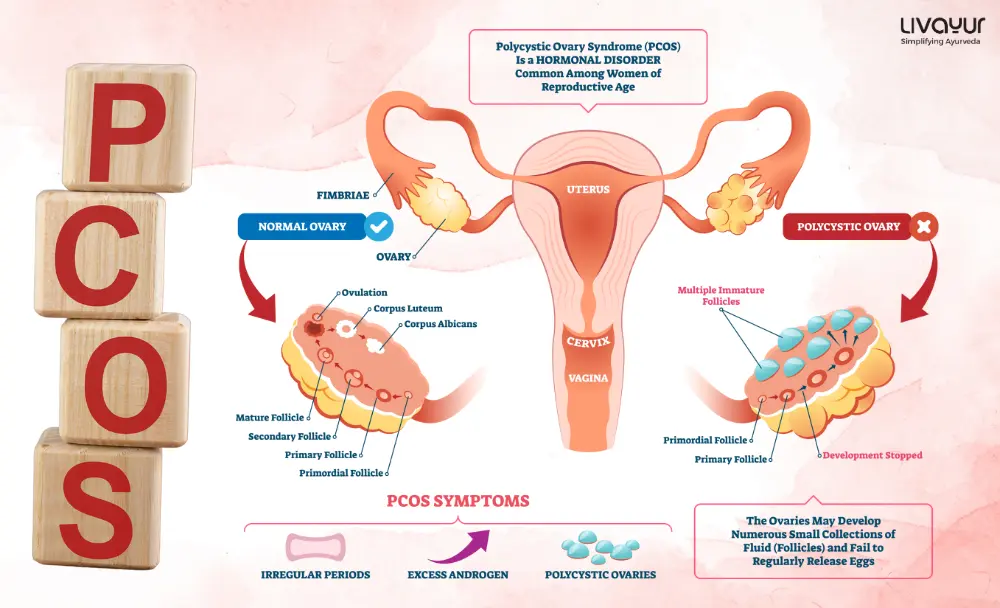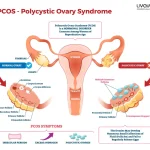
Ovarian cysts are common among women of reproductive age. They are often detected incidentally during routine medical examinations or when investigating specific health concerns. While most ovarian cysts are benign and pose no immediate threat to a woman’s health, it is crucial to understand that not all cysts are identical.
Determining the potential danger of an ovarian cyst depends mainly on its size. This article explores the critical question: “What size of ovarian cyst is dangerous?” We will investigate the various sizes and types of ovarian cysts, their associated risks, and when medical intervention is necessary.
What is an ovarian cyst?
An ovarian cyst is a fluid-filled structure that can develop within or on the surface of a woman’s ovaries. These cysts can vary in size and characteristics and be simple or complex. Simple cysts are typically filled with clear fluid and have thin walls, whereas complex cysts may contain solid components or blood.
Ovarian cysts are often discovered incidentally during routine physical examinations or imaging studies. While many ovarian cysts are harmless and resolve independently, they can lead to complications. These complications include cyst rupture, which can result in severe pain and internal bleeding, ovarian hemorrhage, and torsion, where the cyst causes the ovary to twist upon itself, cutting off its blood supply.
Such situations are considered gynecological emergencies. They underscore the importance of timely diagnosis and appropriate management to prevent potential morbidity and mortality. [1]
Why it’s important to look at the ovarian cyst sizes
Here are several reasons why it’s important to examine and monitor ovarian cyst sizes.
1. Identification of pathological cysts
Ovarian cysts come in various types, and their sizes can help differentiate between functional and pathological cysts. Functional cysts, like follicular cysts, are typically smaller and often resolve without intervention. Pathological cysts, like endometriomas, can be larger and may require medical attention.
2. Risk of rupture
Larger cysts may pose a higher risk of rupture. Ruptured cysts can cause sudden and severe abdominal pain, internal bleeding, and other complications. Monitoring the size allows healthcare providers to assess the risk and determine whether intervention is necessary.
3. Impact on fertility
In some cases, ovarian cysts, especially larger ones, can affect fertility. Cysts may interfere with normal ovarian function or obstruct the fallopian tubes, affecting the release of eggs or the ability of sperm to reach the egg.
4. Symptomatic assessment
The size of ovarian cysts is often correlated with the presence or absence of symptoms. Larger cysts are more likely to cause symptoms like pelvic pain.
5. Cancer screening
While the majority of ovarian cysts are benign, larger cysts may need additional evaluation to rule out the possibility of ovarian cancer.
6. Follow-up and progression monitoring
Regular monitoring of ovarian cyst sizes is essential for tracking changes over time. It helps healthcare providers evaluate the effectiveness of treatment strategies and determine whether the cyst is growing, shrinking, or remaining stable.
Ovarian cyst size chart
Here’s a table for various ovarian cyst sizes and their subsequent implications and management.
| Ovarian Cyst Size | Implications and Management |
| Small (less than 3 cm) | – Often functional cysts that may resolve on their own.- Watchful waiting approach. |
| Moderate (3 – 5 cm) | – May still be functional or represent early pathological cysts.- Monitoring for changes in size and symptoms. |
| Large (5 – 10 cm) | – Increased risk of symptoms like pelvic pain and discomfort. – Possible impact on fertility. – Further evaluation and monitoring are recommended. |
| Very Large (10+ cm) | – Higher risk of complications such as rupture.- Potential impact on fertility- Prompt medical intervention may be necessary. |
Size of ovarian cyst is considered dangerous to health
Here are some points to know when considering the size of ovarian cysts dangerous for one’s health.
- The size of an ovarian cyst is a crucial factor in assessing its potential danger to a woman’s health.
- Typically, any cyst exceeding 10 centimeters in diameter should raise concerns and prompt further investigation.
- Moreover, specific cysts’ characteristics, like a complex multilocular mass, papillary excrescences, irregular shape, and thick septations, warrant heightened suspicion for malignancy.
- In such cases, it is imperative to pursue comprehensive evaluation and diagnostic procedures promptly to determine the nature of the cyst and develop an appropriate treatment plan.
- Early detection and intervention are essential to mitigate potential health risks associated with ovarian cysts. [1]
Symptoms of ovarian cyst
Ovarian cysts can exist within the ovaries without causing any noticeable symptoms. However, they can cause the following symptoms in some women, depending on their size, type, and whether they lead to complications. [1]
1. Pain or pressure in the lower abdomen
Women with ovarian cysts experience discomfort or pain in the lower abdominal region. This pain is typically on one side of the abdomen, corresponding to the ovary affected by the cyst. The nature and intensity of the pain can vary from person to person and may range from a mild, constant ache to sharp, intermittent discomfort.
2. Sudden onset of pain
A ruptured ovarian cyst or torsion (where the cyst causes the ovary to twist) can lead to sudden and intense abdominal pain. The pain can be excruciating and follow nausea and vomiting. These situations require immediate medical attention.
3. Irregular periods
Ovarian cysts can affect hormone production and disrupt the normal menstrual cycle. The disruption can lead to irregular periods, causing variations in the timing and flow of menstruation.
4. Abnormal vaginal bleeding
Some ovarian cysts, particularly those that affect the corpus luteum (a temporary endocrine structure formed during the menstrual cycle), can lead to abnormal vaginal bleeding. It may include spotting between periods or heavier-than-usual menstrual bleeding.
Types of ovarian cysts
Here are some common types of ovarian cysts. [1]
1. Follicular and corpus luteal cysts
Follicular and corpus luteal cysts fall under functional or physiologic cysts and are integral to the normal menstrual cycle. Follicular cysts develop when follicles, the structures containing developing eggs, fail to rupture during ovulation. They typically appear as smooth, thin-walled, and unilocular cysts.
2. Theca lutein cysts
These luteinized follicle cysts form due to overstimulation, often driven by elevated human chorionic gonadotropin (hCG) levels. Theca lutein cysts can occur in various situations, including pregnancy, gestational trophoblastic disease, multiple gestation, and ovarian hyperstimulation.
3. Polycystic ovary syndrome (PCOS)
PCOS is a hormonal disorder affecting women belonging to reproductive age. It is a leading cause of infertility and is associated with diabetes mellitus and cardiovascular disease. PCOS involves multiple small follicular cysts within the ovaries.
4. Neoplastic cysts
Neoplastic cysts result from the abnormal proliferation of cells within the ovary and may be either malignant or benign. They can originate from the ovarian surface epithelium. Benign neoplastic cysts include serous and mucinous tumors characterized by their specific cell types and growth patterns.
5. Dermoid cysts or mature cystic teratomas
Dermoid cysts are unique among ovarian cysts as they contain elements from all three germ layers (ectodermal, mesodermal, and endodermal). They can appear complex due to their diverse tissues, including hair, teeth, and sebaceous material.
6. Endometriosis and endometriomas
Endometriosis is due to endometrial glands and stroma at extrauterine sites, with the ovaries being a shared location. Endometriomas, often called “chocolate cysts” due to their appearance, result from the ectopic growth of endometrial tissue within the ovaries. They contain dark, thick, gelatinous, and aged blood products.
Management of ovarian cyst
Here are some critical aspects of the management of ovarian cysts. [1]
1. Patient factors
Management strategies for ovarian cysts take into account the patient’s age and menopausal status. These factors are essential because certain cyst types’ likelihood and associated risks can vary significantly. They depend on reproductive age and hormonal status.
2. Cyst size
The size of the cyst plays a pivotal role in determining the appropriate course of action. Unilocular cysts smaller than 10 centimeters in diameter are generally considered benign, irrespective of the patient’s age. Such cysts are often closely monitored, particularly if the patient remains asymptomatic.
3. Conservative monitoring
Asymptomatic patients with unilocular cysts smaller than 10 cm manage it conservatively. Conservative management involves serial transvaginal ultrasound examinations at specified intervals. The approach monitors the cyst’s size and characteristics over time. Many cysts, especially functional ones, tend to resolve spontaneously without intervention.
4. Persistence of cyst
If a cyst fails to resolve after several menstrual cycles despite conservative monitoring, it is less likely to be a functional cyst. In such cases, further diagnostic workup is necessary to ascertain the nature of the cyst. It may include additional imaging studies or blood tests.
Managing ovarian cyst with Ayurveda
Ayurveda offers holistic approaches to the management of ovarian cysts. Ayurvedic principles are rooted in the balance of the three Doshas (Vata, Pitta, and Kapha) and aim to address the underlying imbalances contributing to the development of such ailments. Here are some fundamental principles when managing ovarian cysts within an Ayurvedic framework. [2]
1. Kaphaja granthi and vidradhi
In Ayurveda, ovarian cysts are within kaphaja granthi and vidradhi, which are nodular or glandular swellings and abscesses associated with imbalances in the Kapha Dosha. Ayurvedic treatments for ovarian cysts help restore dosha balance and resolve these swellings.
2. Triphaladi kashaya with processed guggulu
Ayurvedic formulations often include herbal remedies. Triphaladi kashaya, combined with processed guggulu (a resin derived from the mukul myrrh tree), is particularly effective in managing ovarian cysts. The treatment approach is attributed to its “shothahara” properties, which aim to alleviate inflammation and swelling. These formulations can have the potential to curtail the progression of ovarian cysts.
In another case study, Ayurveda’s holistic approach to treating ovarian cysts focuses on Kaphaja Granthi. A 27-year-old woman, married for eight months, presented with a 6.6 x 6.1cm ovarian cyst, accompanied by severe lower abdominal pain. Other symptoms included dyspareunia, abdominal bloating, and burning during urination.
Ayurvedic principles guided her treatment, which included Kanchanara guggulu, Sukumaram kashayam, Guggulu panchapala churnam, and Gomutra haritaki for two months. Follow-up ultrasound examinations revealed the complete disappearance of the cyst, and the patient experienced significant relief from her symptoms. [3]
FAQs
1. What size of ovarian cyst is dangerous in mm?
The size of an ovarian cyst is just one factor in determining its potential danger. Generally, cysts more significant than 10 centimeters (100 mm) require closer monitoring or medical intervention, especially if they exhibit suspicious characteristics. However, the size alone does not definitively determine whether a cyst is dangerous; other factors, like type, appearance, and symptoms, also need consideration.
2. At what size should an ovarian cyst be removed?
The decision to remove an ovarian cyst does not solely depend on its size. It depends on various factors, including the cyst’s type and whether it causes symptoms or exhibits features suggesting malignancy. In some cases, cysts larger than 5 centimeters (50 mm) may be considered for removal, but a healthcare professional should make the final decision after a comprehensive evaluation.
3. What size is a harmless ovarian cyst?
Generally, smaller ovarian cysts, typically less than 5 centimeters (50 mm) in size, are more likely to be harmless and may not require immediate medical intervention. However, the size alone is not the sole determinant of a cyst’s harmlessness. A healthcare provider must assess factors like type, appearance, and symptoms to ascertain whether a cyst is benign.
4. How much cyst size is average?
Normal ovarian cysts can vary in size during the menstrual cycle. They typically start small, often less than 2 centimeters, and may grow to around 2 to 5 centimeters during ovulation. However, what is “normal” can vary from person to person. Cysts are generally a normal part of the menstrual cycle when they are small, functional, and cause no symptoms.
5. How do I know if my ovarian cyst is dangerous?
Determining the danger associated with an ovarian cyst needs an evaluation by a healthcare provider. Potential danger signs may include large, complex, persistent cysts or associated with symptoms like severe abdominal pain, nausea, vomiting, or abnormal vaginal bleeding. Imaging tests, like ultrasound and other diagnostic procedures, will help your healthcare provider assess the cyst’s characteristics and guide treatment decisions.
6. How can a cyst be cured naturally?
Natural remedies for ovarian cysts often focus on symptom relief and promoting hormonal balance. These may include dietary changes, herbal supplements, stress management, and regular exercise. While some women find comfort through natural approaches, consulting with a healthcare professional before attempting natural remedies. It will ensure they are safe and appropriate for your condition.
7. What medicine removes ovarian cysts?
Ovarian cyst treatment depends on their type, size, and symptoms. In some cases, hormonal birth control pills may help control the menstrual cycle to prevent new cysts. Surgery may be necessary to remove persistent or problematic cysts. A healthcare provider determines the specific medicine or treatment approach after thoroughly evaluating the individual case.
Conclusion
Managing ovarian cysts is a multifaceted endeavor that requires careful consideration of size, type, and the patient’s circumstances. While smaller, asymptomatic cysts often resolve spontaneously and can be monitored conservatively, larger cysts or those exhibiting concerning characteristics may necessitate medical intervention.
Work closely with your doctor to determine the most appropriate course of action tailored to your condition. Regular gynecological check-ups, early detection, and timely intervention remain pivotal in ensuring the best possible outcomes for individuals with ovarian cysts.
Disclaimer
The information provided here does not intend to replace professional advice or treatment.



















1 Comments